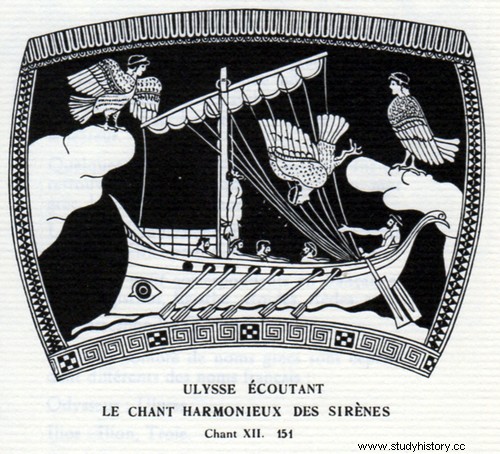Homer's Odyssey has a particularity:although appealing to the marvelous, the poem is not entirely set in a virtual world. The story abounds with geographical or social details, which fascinates researchers.
Note: The excerpts from the Odyssey are taken from the translation of the poet Leconte de Lisle who retained the resonance of the Greek names. Below I give some equivalents simplifying the reading:
The "ai" and "oi" are "e", "é", "è" so "aoides" corresponds to "aède", "Aigisthos" "Aegisthos"
The K corresponds to C, so "Kyklops" "Cyclops", "Kirke" "Circe"
The Kh corresponds to Q
Ulysses is in ancient Greek "Odusseus" and in Latin "Ulixes" and "Odysseus" for Leconte de Lisle
"Ilios" is Troy, "Kèr " is the goddess of death and death
Preamble:the possible stopovers of Ulysses
The cycle of the adventures of Odysseus, as represented in the Odyssey, comprises fourteen episodes, which follow one another in the following order:
 1° Departure from Troy:Odysseus leaves Troy with his flotilla comprising a dozen boats, i.e. a thousand men. He arrives at the Kicones, in Ismaros.
1° Departure from Troy:Odysseus leaves Troy with his flotilla comprising a dozen boats, i.e. a thousand men. He arrives at the Kicones, in Ismaros.
 2° First storm, then after a short lull, gale, which takes Ulysses to the Lotophages.
2° First storm, then after a short lull, gale, which takes Ulysses to the Lotophages.
 3° The Cyclops:Odysseus blinds the Cyclops Polyphemus, son of the god Poseidon, which leads to the curse of Odysseus by this god and his wanderings on the sea.
3° The Cyclops:Odysseus blinds the Cyclops Polyphemus, son of the god Poseidon, which leads to the curse of Odysseus by this god and his wanderings on the sea.
 4° The episode of Aeolus which should have allowed his return.
4° The episode of Aeolus which should have allowed his return.
 5th Landing among the Lestrygons:Ulysses loses eleven ships and escapes with the twelfth.
5th Landing among the Lestrygons:Ulysses loses eleven ships and escapes with the twelfth.
 6th Stay with Circe, the magician who transforms her companions into different beasts
6th Stay with Circe, the magician who transforms her companions into different beasts
 7° Visit to the land of the dead, prediction of its future.
7° Visit to the land of the dead, prediction of its future.
 8° The Song of the Sirens.
8° The Song of the Sirens.
 9° The pitfalls Charybdis and Scylla.
9° The pitfalls Charybdis and Scylla.
 10° The island of Thrinakié and the oxen of the Sun.
10° The island of Thrinakié and the oxen of the Sun.
 11° Second storm, Odysseus escapes death alone and arrives at Calypso.
11° Second storm, Odysseus escapes death alone and arrives at Calypso.
 12th Stay with Calypso; deliverance and departure of Odysseus.
12th Stay with Calypso; deliverance and departure of Odysseus.
 13° Third Storm:Shipwrecked Odysseus lands among the Phaeacians.
13° Third Storm:Shipwrecked Odysseus lands among the Phaeacians.
 14° Odysseus returns to Ithaca alone and incognito.
14° Odysseus returns to Ithaca alone and incognito.
Dating back to 700 years before our era, the journey of Ulysses (Odysseus in Greek) sung by Homer gives pride of place to imagination, metaphor, mythological wonder. According to the sources, it would be several stories collected and shaped by the legendary bard Homer. Throughout the story, we are struck by certain descriptions highlighting the particularities of places, customs and peoples:it is as if the storyteller, leaving the poetry all its mystery, delivered a few "bitters" (maritime location in relation to singular points of the coast) that could suggest certain stopovers and was content for others to remain in the pure imagination.
Certain shores and places of passage are the subject of a precise description noting their singularities while others can only come from mythology:but beware, if Olympus is the mythical abode of the gods, Mount Olympus does not exist any less! And if Homer meticulously describes a site, maybe it's because that site exists.
For certain stopovers, Homer uses landmarks known to Greek navigators (the abrupt aspect of an island, the violent currents of a strait, the eaters of lotos, a gigantic eye in the mountains, the absolute calm of a port with its source and its town high, …). He makes it the framework of “Homeric” acts and gestures. Almost in each stage of the journey, but to varying degrees, we find in the story concrete elements allowing identifications and, superimposed, a marvelous episode.
At all times, the tale has not adapted well to very frequented or populated places:the domain of the imagination is the impenetrable forest, the wild mountain, the marshes, ponds and peat bogs, the deep lakes and the tumultuous rivers, it is difficult to see the Lorelei living in a city on the banks of the Rhine or the vampires leaving the Carpathian Mountains to live in the plain. Also, it is useless to seek on the coasts frequented by the merchant navigators of this time the stopovers which are objects of legendary meetings, the marvelous would not be credible there. The tale, when it is a source of wonder, can be based on real but little frequented sites.
To date, more or less plausible hypotheses exist concerning the locations of the stopovers, the prize going to the whimsical Alain Bombard who takes Ulysses and his companions to Great Britain and Iceland.
The Odyssey making no mention of the phenomenon of high Atlantic tides, the cause is understood, not to mention the inappropriate hull of the Mediterranean ships at the great swell of the ocean, and for example the well-known pitfalls Charybdis and Scylla at the vicinity of Sicily (Strait of Messina) or the domain of Aeolus in the "Aeolian" islands. Before looking for these stopovers, it is essential to list the regions where the storyteller could not locate them. Researchers have often mobilized meteorological science and time indications to trace possible routes; it is a misunderstanding of the Mediterranean, subject to sudden gales, local or otherwise, and to equally unexpected swell and wind reversals, we are far from the established monsoon winds, here any meteorological hypothesis assumes the opposite! This research has also led to questionable conclusions, for example, Ulysses sailing to Crimea or Iceland. Let's not forget that the ships were equipped with oars to compensate for the frequent flat calms of the Mediterranean, which further complicates the search for possible routes.
Most of the routes offered to date are from the adaptation of the Odyssey by Victor Bérard who went to sea in search of the routes of Ulysses with the means at his disposal at the time. His proposals are all based on the possible sea routes that could be taken by Odysseus. Victor Bérard had taken it for granted that Homer had invented nothing at the geographical level and he had traveled the Mediterranean by boat, researching the sites, relying on the possibilities of navigation:for him, the succession of stops would be controlled by the geography and meteorology, which is perplexing because the spider's web of successive routes is very tangled.
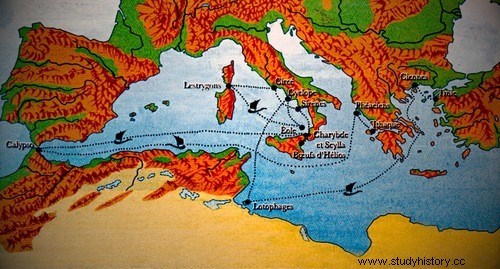
For my part, I am more inclined to consider the chronology of stopovers imposed by a concern for consistency:in other words, it is the annihilation of the boats of the flotilla of Ulysses and the gradual disappearance of his crew that will allow to sequence the episodes, which the storyteller could not do if the thousand men of his flotilla had accompanied Odysseus all the way to Ithaca. In this hypothesis, the complexity of the maritime journeys between the stopovers does not come into play, the main thing for the storyteller seems to be the continuity of the story and, to hold the attention of the audience, the concern to make the unfolding of this long journey credible. trip.
To captivate the audience, the veracity of the Mediterranean course, although artificial, had to be admitted:the “fast ships” could only painfully go up against the wind, local or non-local gales are frequent, and still often unpredictable, in Mediterranean; it is therefore not surprising that the "routes of the wind" taken by will or by force are complex (for example it is possible that, having arrived at the entrance to the Adriatic to reach Ithaca, Ulysses would be driven back far towards West by a storm). It should also be understood that the shores are rugged, not very conducive to safe anchorages, precarious shelters are more frequent than ports sheltered from all winds, the number of wrecks lying along the coasts attests to these Mediterranean particularities.
I would add that the storyteller is well documented:attests to this, for example, in the details provided for the construction of Ulysses' makeshift boat, the characteristics specific to certain sites or the ways of doing things of certain populations carefully described.
“Finally, preparing the departure of the magnanimous Odysseus, she (Calypso) gave him a great ax of brass, well in hand, with two edges and with a beautiful handle made of olive wood. And she then gave him a sharp doloire. And she led him to the extremity of the island where tall trees grew, alders, poplars and pines which reached the Ouranos, and whose dry wood would float more lightly. And, having shown him the place where the great trees grew, the illustrious goddess Kalypsô returned to her dwelling.
And immediately Odysseus cut down the trees and did his work promptly. And he cut down twenty of them which he limbed, squared and aligned with a chalk line. During this time the illustrious goddess Kalypsô brought augers; and he pierced the timbers and joined them together, binding them with pegs and cords. As great was the hold of a cargo ship built by an excellent workman, so great was the raft built by Odysseus. And he raised a bridge which he made with thick planks; and he cut a mast to which he attached the aerial. Then he made the rudder, which he fitted with willow screens to resist the shock of the waves; then he piled up a great ballast. During this time, the illustrious goddess Kalypso brought canvas to make the sails, and he made them skillfully and tied them to the antennae with cords.”
Before advancing a hypothesis concerning the possible site of a stopover, it is imperative to take into consideration the entire text of the poem, each word, each sentence of the bard counts; the plot of the story, out of the marvelous context, is precise. Moreover, it is not because I have not succeeded in locating a stopover that it does not exist, if it is the subject of a detailed description:other researchers may be more inspired.
The departure from Troy and the first stopover
“From Troy the wind carried me to the Cicones, to Ismaros”
First example of navigation difficulties! Departing from Troy, Odysseus and his flotilla of 12 sailing and rowing boats are pushed by a southerly wind towards the northern Aegean Sea, in Thrace, on the current border between Greece and Turkey, the site of Ismaros exists and it has not changed its name, located in Maronia, in Thrace, in the extreme north of Greece. The Cicones were to be allies of the Trojans.
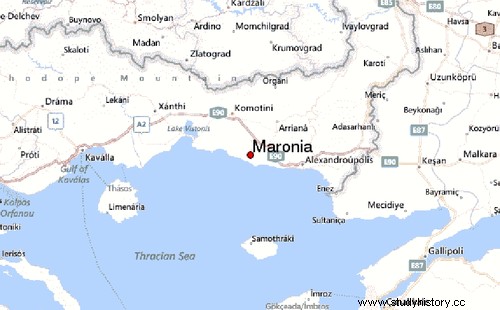
-
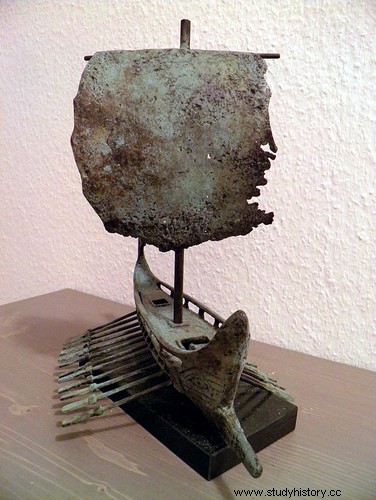
- antique bronze model
The naves of Ulysses were to resemble this πεντηκόντερος "pentécontéros", decked warship from the time of the Trojan War:it measures approximately 35 m by 5 m and the crew is 48 rowers (2 rowers per oar) , all free men or "wogs", it is necessary to add a helmsman and other sailors for the maneuvers of the sails. The hypothesis of a hundred men per boat is therefore plausible. The biremes, triremes and other boats with several levels of superimposed rowers are posterior.
This stopover was necessary because the thousand men making up the flotilla were leaving Troy, a city besieged for 10 years, therefore very devoid of food. Ulysses therefore had to obtain road supplies from this site near Troy before continuing. According to the eternal and fatal custom, they sacked the city then, after having lost 6 companions, Ulysses set out again, pushed by the Boreas, that is to say the north wind and dragged by a storm further south. lands 10 days later on the land of the Lotus-eaters with all his companions, far from Ithaca.
Second stopover, Lotophages
“The Lotus-eaters did them no harm, but they offered them lotos to eat. And as soon as they had eaten the sweet lotos, they thought no more, neither of their message, nor of their return; but, full of forgetfulness, they wanted to stay with the Lotus-eaters and eat lotos.”
Undoubtedly, the Lotophages (lotus eaters) inhabit the African coast, between Libya and present-day Egypt, countries where the soporific virtues of certain plants were known and used. Note that this is not the lotus commonly represented in Egypt because the name "lotos" was generic, given to several varieties of seeds, fruits or leaves. For information, the blue lotus cited by some is described on the net as either a soothing soft drug or a hallucinogenic stimulant! This stopover, however, allows us to affirm that Homer located the action on the African shore, without giving the exact place:the consumption of lotos must have been something known in all these countries. At this time, Odysseus still has every chance of returning to Ithaca without damage, … if the wind is favorable to him and especially if the bard wishes.
The land of the Cyclops
The encounter with the monstrous Polyphemus, blinded by Ulysses, will engender the curse of the Cyclops' father, Poseidon, god of the sea, who will constantly thwart Ulysses' return. We will then witness a succession of episodes which will gradually annihilate the small army of Ulysses (a dozen boats, or a thousand men) and make him return alone and incognito to Ithaca, ten years after his departure from Troy.
No other stopover is described with as much topographical and social precision, so it is surprising that researchers did not bother to look for where this country of the Cyclops could be found when they claimed to locate other much more vaguely described stops. by the storyteller.
This great profusion of details suggests that the storyteller has collected a great deal of information about the region and its inhabitants:the manners and customs of these "barbarians" (for the Greeks, it is the one who is a foreigner), very different from the Greek democratic organization, must have intrigued the Greek navigators. The various translations, including the literal translation, which is usually richer in detail, differ little from each other in this episode.
In the following excerpt, it is striking that only the last paragraph appeals to the marvelous while the previous ones describe places, inhabitants and social organization without indicating the physical particularity of this people, that is to say the single eye! Homer first multiplies the precise indications concerning this land and the characteristics of the population before moving on to the marvelous.
“And they went up there, and, sitting down in order on the benches of rowers, struck with their oars the white sea, and we sailed again, sad in heart. And we came to the land of the proud and lawless Cyclops who, trusting in the immortal Gods, neither plant with their hands nor plow. But, being neither sown nor cultivated, all the plants grow for them, the wheat and the barley, and the vines which give them wine from their great bunches which the rains of Zeus make grow. And the agoras are not known to them, nor the customs; and they dwell on the tops of high mountains, in deep caverns, and each of them governs his wife and children, without any care for the others.
A small island is in front of the port of the land of the Cyclopes, neither near nor far. It is covered with forests where wild goats multiply. And the presence of men has never frightened them, because the hunters who support the pains in the woods and the fatigues on the top of the mountains do not traverse this island. We do not graze herds there and we do not plow there; but it is neither sown nor plowed; it lacks inhabitants and it feeds only bleating goats. For the Cyclopes have no naves painted red, and they have no builders of naves with benches of rowers who carry them to the cities of men, as these cross the sea towards each other. , so that, on these naves, they can come to inhabit this island. But this one is not sterile, and it would produce all things according to the seasons. There are soft watered meadows on the edge of the white sea, and vines would grow abundantly there, and this land would yield crops easily, for it is very rich. Its harbor is safe, and there is no need of ropes, or dropped anchors, or tying of cables; and sailors can stay there as long as their soul desires and wait for the wind. At the bottom of the port, a limpid spring flows under a cave, and the alder grows around.
There we were pushed, and a God led us there during a dark night, for we couldn't see anything. And a thick fog enveloped the naves, and Selene did not shine in the Ouranos, being covered with clouds. And none of us saw the island with our eyes, nor the great waves that rolled towards the shore, until our ships with the benches of rowers had landed there. Then we drew up all the sails and went down to the shore of the sea, then, having fallen asleep, we waited for the divine Eos.
When rosy-fingered Eos, born in the morning, appeared, admiring the island, we traversed it. And the Nymphs, daughters of tempestuous Zeus, made the mountain goats get up, so that my companions could make their meal. And immediately they drew from the naves the curved bows and the spears with long points of bronze, and, divided into three bodies, we cast our arrows, and a God gave us an abundant hunt. Twelve ships followed me, and to each the lot granted nine goats, and ten to mine. Thus, all day, until the fall of Helios, we ate, seated, the flesh abundant, and we drank red wine; but there were still some left in the many amphoras we had from the sacred citadel of the Kicones. And we saw the smoke on the next land of the Cyclopes, and we heard their voice, and that of the sheep and the goats. And when Helios fell, night came, we fell asleep on the shore of the sea. And when rosy-fingered Eos, born in the morning, appeared, having summoned the agora, I say to all my companions:
— Stay here, my dear companions. I, with my ship and my rowers, will go and see who these men are, whether they are abusive, savage and unjust, or whether they are hospitable and fearing the Gods.
Having thus spoken, I climbed onto my nave and ordered my companions to climb up and untie the cable. And they went up, in order on the benches of rowers, they struck the white sea with their oars. laurels, near the sea. And there lay many herds of sheep and goats. Nearby was an enclosure paved with hewn stones and surrounded by tall pines and tall oak trees. There dwelt a giant who, alone and far from all, herded his flocks, and did not mingle with others, but lived apart, doing evil. And it was a prodigious monster, not like a man eating bread, but on the wooded peak of a high mountain, which stands alone among the other peaks.”
First of all, we must discard the very common hypothesis identifying the Cyclops with a volcano:the mouth of a volcano cannot be both a giant and the entrance to the infernal underworld, the domain of the blacksmith god Hephaestus ( Vulcan among the Romans):Etna was generally reputed to be this forge and in an earlier time the cyclops were the helpers of the blacksmith god, this before leaving Etna and changing countries. In the Iliad and the Odyssey, Homer constantly evokes the relationship between men and the mythological pantheon, goddesses, gods and demi-divinities, protective or not. He would not have committed this confusion. In addition, the eye of the Cyclops was to be seen from the sea, and not from the sky.
It is therefore necessary to find in the Mediterranean a people of "proud and lawless" shepherds, inhabitants of the wooded mountains, far from the coasts, living in family clans, practicing rudimentary agriculture and having no maritime character, "the Cyclopes did not have any naves painted red", let alone boat builders (it's in the literal text). This description reduces the number of possible peoples around the Mediterranean because non-sailing Mediterranean peoples who live far from the coasts are rare.
The shore of the island features a calm natural harbor where approaches Odysseus and there is a spring; the island is not exploited by the inhabitants and it is delivered to the wild “mountain” goats, it is “neither near nor far” from the land of the Cyclopes. And to be precise, starting from this port and skirting the land of the Cyclops, you have to find a high mountain, alone in the middle of the other peaks, with an eye clearly visible from the sea, the one that Homer personalizes in this living cyclops Polyphemus “ alone and far from all”, “like a high mountain”. It is indeed the description of a mountain similar “to the wooded summit of a high mountain, which stands alone, in the middle of the other peaks” and “not similar to a man who eats bread”, the poet would therefore transform the real mountain into a legendary giant and not the other way around.
All of these elements have a coherent solution at all points on the western slope of Corsica which, at that time, was inhabited (see the work of Michel Claude Weiss and his team from Corte) but practically without contact with the outside :
The shores of the island are then unhealthy, maritime activities absent. The land of the Cyclopes may be the peninsula of Scandola, mountainous, wooded, uninhabited even today except by wild goats and wild boars. It is located between the gulfs of Girolata and Galéria, north of the Gulf of Porto. The fact that it is a peninsula and not an island is not a problem, we will see later that the recognized sites of Circe and Calypso are in the same configuration, moreover when Ulysses approaches this island, he does not not distinguish the contours, embarrassed by a thick mist (literal text). The volcanic rock walls composed of rhyolite falling into the sea have very many and remarkable tafoni, giant holes and porches, it is a “people of eyes”. It is only connected to the land by the Palmarella pass. Nowhere else on the Mediterranean shores are these jagged, perforated landforms so grouped together, very different from the granitic landscapes "in balls" or limestone cliffs. It should be added that this region, which is very (too) busy today, was only known to a few locals until the 1960s and could easily have escaped the attention of researchers.
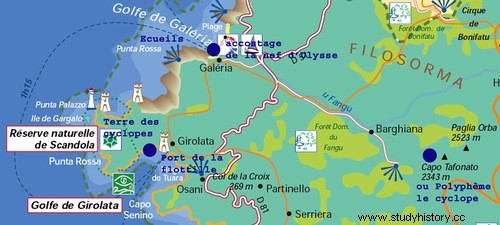
Ulysses shelters his flotilla at Girolata, neither close nor far from the Cyclops, crosses with his only crew the land of the Cyclops, that is to say the tormented, hollow or pierced reliefs of Scandola, and lands in the mouth of the Fango , from where he sees the eye of the cyclops Polyphemus who lived alone away from everyone (the other cyclops). On leaving he avoids the two rocks thrown by Polyphemus, that is to say the two pitfalls located at the exit of the Gulf of Galéria, between the eye of the tip of Stolo and Alpa Néra.
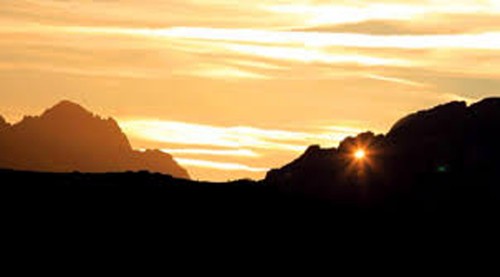
In the evening, seen from the eastern slope, the sun pierces the Capo Tafonato. From the western slope the same phenomenon occurs at sunrise, allowing the sea to see the dawn (Eos with rosy fingers), then Helios, the rising sun, sparkling through the hole. Sailors today, like those on the Odyssey, know this singularity.
The safe harbor should be the bay of Girolata with fresh water. Girolata, "neither too close nor too far" from the Cyclops, is the only really safe shelter on this westernmost part of the coast of Corsica, subject to currents and gales, shelter frequented since antiquity because it is protected from all the winds and having a sandy coast and fresh water, a real natural and safe harbor even today. Let us add that Girolata, not far from Scandola, is not part of the country of the Cyclops, it adjoins it, the volcanic reliefs in the shape of eyes only beginning at the exit from the gulf:Homer's description is therefore precise. Ulysses leaves his flotilla there because the Poyphemus episode could not exist with a thousand men entering the Cyclops' cave!
-
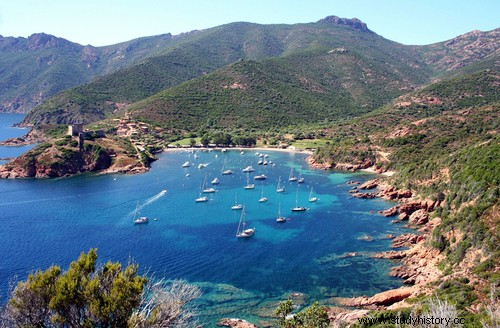
- The natural port of Girolata
When the nave of Ulysses goes up alone from Girolata towards the north, it skirts Scandola, the bays of Elbo and Focolara (domains of the tafoni) and it quickly arrives in the Gulf of Galéria (which is only a precarious maritime shelter ) passing the tip of Stolo and its rock pierced by a small eye; the navigator inevitably sees Capo Tafonato (2335 m.), its gigantic characteristic eye clearly visible from the sea with its 35 m opening. by 10m. standing out from the other peaks (Cinto, Punta Minuta and Paglia Orba) and next to it the great vertical cliff of the Paglia Orba, well identifiable even in foggy weather. Note that Scandola is the extreme western tip of Corsica, undoubtedly a singular point for ancient navigators (today equipped with Gargalo fire).
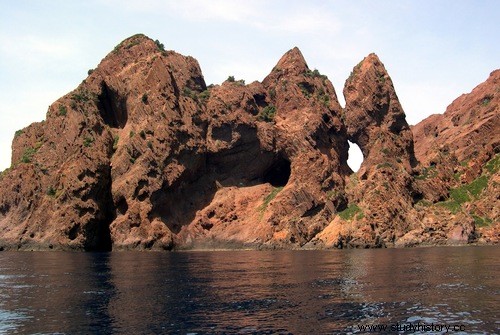
it is still very common to see wild goats in the hole, or lower down, coming for shade or to lick the sea salt.
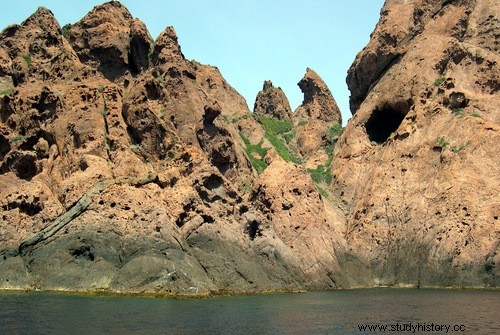
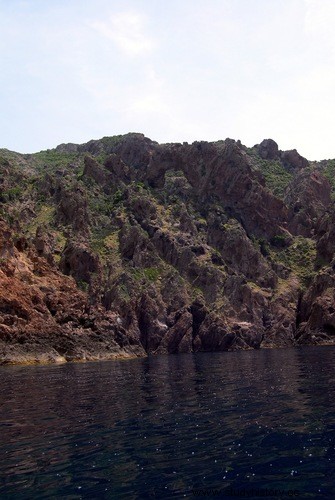
In the upper part, one of the large porches dug by erosion and on the sea, an invasion of small harmless jellyfish, the velelles.
The mouth of the Fango ("Fango", the mire) which spreads out in a delta before reaching the sea was for a long time unhealthy and without inhabitants or cultures, despite the successive attempts at colonization by the Romans, Pisa and Genoa. The shepherd people lived on the heights to the foot of the mountains at the end of the ten km long valley leading to the foot of Capo Tafonato.
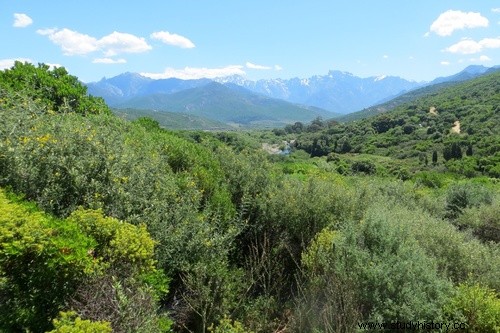
From the shore, the Fango valley and the mountains (Le Capo Tafonato to the south of the Paglia Orba cliff, to the north the Punta Minuta and to its left you can barely make out the summit of Cinto, 2700 m). The eye of the Tafonato is clearly visible on clear days, especially in the morning.
-
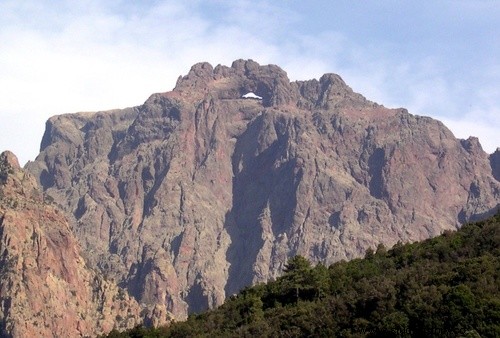
- View from the Fango valley, Capo Tafonato and its eye (2335 m) and its vertical western slope
Finally, leaving the Gulf of Galéria, returning to the port of Girolata, we find at sea, not far from the shore, the two rocks that the Cyclops, blinded by Ulysses, threw into the sea. These are 2 large pitfalls, known under the names of 'Ecueil de terre et Ecueil de mer (ils sont devenus aux temps chrétiens les morceaux manquants du Capo Tafonato :le diable, suite à un pari perdu, a lancé un soc de charrue depuis le lac de Nino, soc qui traversa cette montagne et la troua; comme quoi ces singularités du relief ne passent toujours pas inaperçues et donnent interprétations légendaires).
Ma conclusion est que si Homère a inventé le site de cette escale, il a fait preuve d’une imagination qui confine à cette réalité corse, si non è vero, è ben trovato !
La demeure d’Eole, dieu de tous les vents
Partant de la côte ouest de la Corse, Ulysse navigue plein sud pour regagner Ithaque, il fait escale dans le domaine d’Eole (Aioliè, le Maître de tous les vents).
Ignorant la malédiction jetée sur lui par Poséidon, protégé par Eole, il reçoit du Dieu une outre renfermant tous les vents, sauf le doux zéphyr qui doit le pousser jusqu’à Ithaque (en Adriatique).
“Et nous arrivâmes à l’île Aioliè, où habitait Aiolos Hippotade cher aux dieux immortels. Et un mur d’airain qu’on ne peut rompre entourait l’île entière, et une roche escarpée la bordait de toute part.”
Odyssée, Chant X, 1 - 15 (traduction Leconte de Lisle)
" Nous gagnons Eolie, où le fils d’Hippotès, cher aux dieux immortels, Eole, a sa demeure. C’est une île qui flotte :une côte de bronze, infrangible muraille, l’encercle tout entière; une roche polie en pointe vers le ciel.”
Odyssée, Chant X, 1 - 15 (traduction Victor Bérard)
Cette comparaison des deux traductions fournit un bon exemple des écarts des traducteurs. Pour le texte grec qui dit "dans une île flottante", Leconte de Lisle omet cette phrase caractéristique qui doit l’intriguer et Bérard traduit “c’est une île qui flotte” :Homère peut signifier que l’île peut, soit être composée en partie de pierre ponce (qui flotte sur l’eau), soit comme toutes les îles elle peut sembler aérienne en cas de brume maritime.
En fait, la description d’Homère s’applique suffisamment à Stromboli, île-volcan pyramidale sombre, sans aucune plage facilitant l’abordage, très escarpée, de préférence aux 6 autres îles des Lipari (appelées aussi îles éoliennes) qui n’ont pas ce “mur d’airain qu’on ne peut rompre”. Il faut aussi se souvenir que Zeus avait ordonné que les vents soient enfermés par Eole dans de profondes grottes sous une énorme montagne dont le poids empêcherait les Vents de sortir :en effet, la sortie de l’ensemble des Vents détruirait non seulement la terre mais le ciel (l’Ouranos). Le profil pyramidal de Stromboli est bien adapté à cette fonction.
-
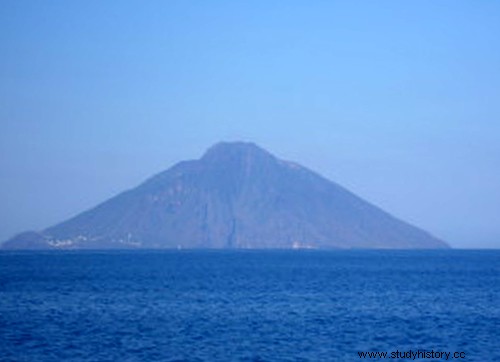
- Stromboli, île impressionnante avec son volcan actif, sa couleur sombre et son rivage abrupt
-
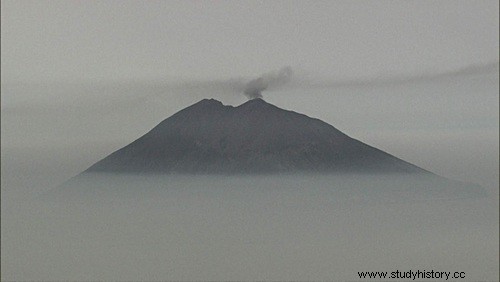
- Dans la brume de mer, l’île semble en effet très aérienne et surréelle, flottant dans l’espace et couronnée par le panache de fumée du volcan
Alors que la nef d’Ulysse approche d’Ithaque, pendant son sommeil, ses compagnons ouvrent l’outre renfermant les vents, croyant qu’Ulysse y a dissimulé un trésor. Les vents en sortent en tempête et le ramènent au domaine d’Eole.
Eole ne peut protéger un homme maudit des dieux et le chasse. Ulysse reprend la mer et au bout de 6 jours et six nuits arrive au pays des Lestrygons.
Les Lestrygons
“Il parla ainsi, et il me chassa de ses demeures tandis que je soupirais profondément. Et nous naviguions de là, tristes dans le cœur; et l’âme de mes compagnons était accablée par la fatigue cruelle des avirons, car le retour ne nous semblait plus possible, à cause de notre démence. Et nous naviguâmes ainsi six jours et six nuits. Et, le septième jour, nous arrivâmes à la haute ville de Lamos, dans la Lestrygonie Télépyle. Là, le pasteur qui rentre appelle le pasteur qui sort en l’entendant. Là, le pasteur qui ne dort pas gagne un salaire double, en menant paître les bœufs d’abord, et, ensuite, les troupeaux aux blanches laines, tant les chemins du jour sont proches des chemins de la nuit. Et nous abordâmes le port illustre entouré d’un haut rocher. Et, des deux les rivages escarpés se rencontraient, ne laissant qu’une entrée étroite. Et mes compagnons conduisirent là toutes les nefs égales, et ils les amarrèrent, les unes auprès des autres, au fond du port, où jamais le flot ne se soulevait, ni peu, ni beaucoup, et où il y avait une constante |tranquillité. Et, moi seul, je retins ma nef noire en dehors, et je l’amarrai aux pointes du rocher. Puis, je montai sur le faîte des écueils, et je ne vis ni les travaux des bœufs, ni ceux des hommes, et je ne vis que de la fumée qui s’élevait de terre. Alors, je choisis deux de mes compagnons et un héraut, et je les envoyai pour savoir quels hommes nourris de pain habitaient cette terre. Et ils partirent, prenant un large chemin par où les chars portaient à la Ville le bois des hautes montagnes. Et ils rencontrèrent devant la Ville, allant chercher de l’eau, une jeune vierge, fille du robuste Lestrygon Antiphatès. Et elle descendait à la fontaine limpide d’Artakiè. Et c’est là qu’on puisait de l’eau pour la Ville. S’approchant d’elle, ils lui demandèrent quel était le roi qui commandait à ces peuples; et elle leur montra aussitôt la haute demeure de son père. Etant entrés dans l’illustre demeure, ils y trouvèrent une femme haute comme une montagne, et ils en furent épouvantés. Mais elle appela aussitôt de l’agora l’illustre Antiphatès, son mari, qui leur prépara une lugubre destinée, car il saisit un de mes compagnons pour le dévorer. Et les deux autres, précipitant leur fuite, revinrent aux nefs. Alors, Antiphatès poussa des clameurs par la Ville, et les robustes Lestrygones, l’ayant entendu, se ruaient de toutes parts, innombrables, et pareils, non à des hommes, mais à des géants. Et ils lançaient de lourdes pierres arrachées au rocher, et un horrible retentissement s’éleva d’hommes mourants et de nefs écrasées. Et les Lestrygones transper-çaient les hommes comme des poissons, et ils emportaient ces tristes mets. Pendant qu’ils les tuaient ainsi dans l’intérieur du port, je tirai de la gaine mon épée aiguë et je coupai les câbles de ma nef noire, et, aussitôt, j’ordonnai à mes compagnons de se courber sur les avirons, afin de fuir notre perte. Et tous, ensemble, se courbèrent sur les avirons, craignant la mort. Ainsi ma nef gagna la pleine mer, évitant les lourdes pierres; mais toutes les autres périrent en ce lieu.”
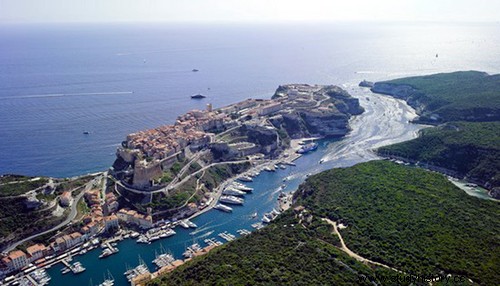
La description du site est sans équivoque :Un port à l’entrée étroite, sans jamais aucune houle, bordé des deux côtés par de hautes falaises, une ville haute et une source éloignée de la cité, c’est le site de Bonifacio. Il est aussi fait mention des hautes montagnes fournissant le bois. Et la nef d’Ulysse restant prudemment à l’extérieur ne peut que s’amarrer “ aux pointes du rocher”.
Par contre, le site de Porto Pozzo, en Sardaigne, dans les Bouches de Bonifacio, est choisi par beaucoup de chercheurs :c’est bien un port très protégé, mais on n’y retrouve ni les hautes falaises tombant directement en mer, ni la ville haute sur son haut rocher, ni la source éloignée de la cité "elle descendait à la fontaine limpide d’Artakiè. Et c’est là qu’on puisait de l’eau pour la Ville", ni les hautes montagnes d’où tirer le bois. J’ajoute que “le pasteur qui rentre appelle le pasteur qui sort en l’entendant” fait penser aux traditionnels appels des bergers corses. La phrase “tant les chemins du jour sont proches des chemins de la nuit” pourrait être la remarque que dans ce pays plus au nord que la Grèce les nuits d’été (en hiver, peu de navigation) sont plus courtes qu’en Grèce.
Le site de Bonifacio était occupé depuis la préhistoire (découverte de la "dame de Bonifacio"). La fontaine pourrait être celle de Longone, à environ 700 m de la marine, et non la source Saint Barthélémy en bas de la faille dite "escalier du roi d’Aragon", également connue mais difficile d’accès.
-
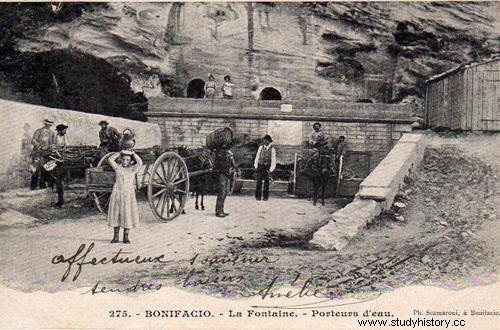
- La fontaine d’Artakiè ? Peut-être, en tout cas la jeune vierge porteuse d’eau est bien là !
La place de cet épisode dans le récit est capitale, elle permet de réduire à un seul équipage la flottille :tous les épisodes suivants ne pourraient se réaliser avec la flotte initiale.
CIRCE, la magicienne
"Et nous naviguions loin de là, tristes dans le cœur d’avoir perdu tous nos chers compagnons, bien que joyeux d’avoir évité la mort. Et nous arrivâmes à l’île Aiaiè, et c’est là qu’habitait Kirkè aux beaux cheveux, vénérable et éloquente déesse, sœur du prudent Aiètès. Et tous deux étaient nés de Hèlios qui éclaire les hommes, et leur mère était Persè, qu’engendra Okéanos. Et là, sur le rivage, nous conduisîmes notre nef dans une large rade, et un dieu nous y mena. Puis, étant descendus, nous restâmes là deux jours, l’âme accablée de fatigue et de douleur. Mais quand Éôs aux beaux cheveux amena le troisième jour, prenant ma lance et mon épée aiguë, je quittai la nef et je montai sur une hauteur d’où je pusse voir des hommes et entendre leurs voix. Et, du sommet escarpé où j’étais monté, je vis s’élever de la terre large, à travers une forêt de chênes épais, la fumée des demeures de Kirkè."
-
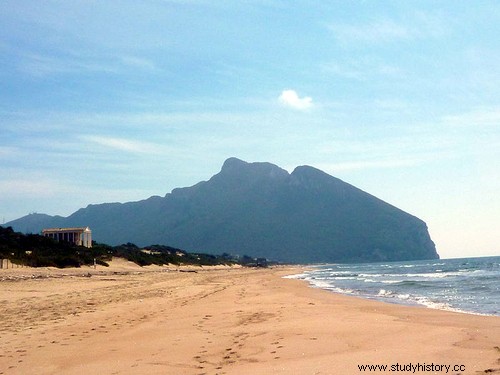
- Située dans le Latium, la demeure supposée de Circé domine la mer au milieu d’un paysage plat.
"Du faîte de la hauteur où j’ai monté, j’ai vu que cette terre est une île que la mer sans bornes environne. Elle est petite, et j’ai vu de la fumée s’élever à travers une forêt de chênes épais."
Le site de cette escale est décrit de manière succincte :ou bien c’était un site connu des navigateurs grecs (comme la première escale Ismaros), ou bien l’aède a "inventé" ce site, laissant le mystère autour de la magicienne. En tout cas, encore une fois il s’agit d’un amer pour les marins, un gros mont au profil caractéristique sur un rivage fort plat, c’est un repère indispensable pour les marins, pratiquement un phare.
"Et elle leur offrit cela, et ils burent, et, aussitôt, les frappant d’une baguette, elle les renferma dans les étables à porcs. Et ils avaient la tête, la voix, le corps et les soies du porc, mais leur esprit était le même qu’auparavant. Et ils pleuraient, ainsi renfermés; et Kirkè leur donna du gland de chêne et du fruit de cornouiller à manger, ce que mangent toujours les porcs qui couchent sur la terre."
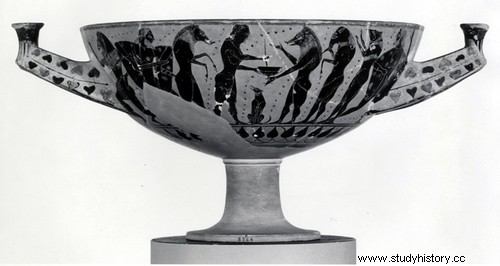
Ulysse auquel le dieu Hermès a donné un antidote va sauver ses hommes et après un séjour d’un an pourra repartir. Circé lui enjoint d’aller au séjour des morts pour consulter un devin.
Au seuil de la demeure d’Adès
“Vous pensiez peut-être que nous partions pour notre demeure et pour la chère terre de la patrie ? Mais Kirkè nous ordonne de suivre une autre route, vers la demeure d’Aidès et de l’implacable Perséphonéia, afin de consulter l’âme du Thébain Teirésias.”
Ulysse rencontre les âmes des morts illustres et le devin Thyrésias lui prédit son avenir, que de difficultés l’attendent !
Au contraire d’Orphé et autres mortels, Ulysse, sur les indications de Circé, ne pénètre pas dans le séjour des morts :il ne franchit pas le Styx sur la barque de Charon. C’est donc au seuil de ce domaine qu’il va procéder aux libations et cérémonies qui vont lui permettre de rencontrer les âmes. Encore une fois, le récit d’Homère fait preuve d’un grand souci du détail, tout concoure à la "vraisemblance du conte".
“Tu désires un retour très facile, illustre Odysseus, mais un dieu te le rendra difficile; car je ne pense pas que celui qui entoure la terre apaise sa colère dans son cœur, et il est irrité parce que tu as aveuglé son fils. Vous arriverez cependant, après avoir beaucoup souffert, si tu veux contenir ton esprit et celui de tes compagnons. En ce temps, quand ta nef solide aura abordé l’île Thrinakiè, où vous échapperez à la sombre mer, vous trouverez là, paissant, les bœufs et les gras troupeaux de Hèlios qui voit et entend tout. Si vous les laissez sains et saufs, si tu te souviens de ton retour, vous parviendrez tous dans Ithakè, après avoir beaucoup souffert; mais, si tu les blesses, je te prédis la perte de ta nef et de tes compagnons. Tu échapperas seul, et tu reviendras misérablement, ayant perdu ta nef et tes compagnons, sur une nef étrangère.”
Dans cet épisode (dans ce chant) l’aède va longuement conter les amours et les combats des immortels et des mortels, c’est un exposé vivant de la mythologie grecque. Ulysse converse aussi avec les âmes de ses parents et amis.
De retour dans la demeure de Circé, celle-ci confirme l’oracle et met en garde Ulysse contre les dangers qui sont sur sa route, les Sirènes, les terribles écueils Charibde et Sylla et les bœufs du dieu Soleil.
Le chant des Sirènes
“Ô amis, il ne faut pas qu’un seul, et même deux seulement d’entre nous, sachent ce que m’a prédit la noble déesse Kirkè; mais il faut que nous le sachions tous, et je vous le dirai. Nous mourrons après, ou, évitant le danger, nous échapperons à la mort et à la kèr. Avant tout, elle nous ordonne de fuir le chant et la prairie des divines Seirènes, et à moi seul elle permet de les écouter; mais liez-moi fortement avec des cordes, debout contre le, mât, afin que j’y reste immobile, et, si je vous supplie et vous ordonne de me délier, alors, au contraire, chargez-moi de plus de liens.
Et je disais cela à mes compagnons, et, pendant ce temps, la nef bien construite approcha rapidement de l’île des Seirènes, tant le vent favorable nous poussait; mais il s’apaisa aussitôt, et il fit silence, et un daimôn assoupit les flots. Alors, mes compagnons, se levant, plièrent les voiles et les déposèrent dans la nef creuse; et, s’étant assis, ils blanchirent l’eau avec leurs avirons polis.
Et je coupai, à l’aide de l’airain tranchant, une grande masse ronde de cire, dont je pressai les morceaux dans mes fortes mains; et la cire s’amollit, car la chaleur du roi Hèlios était brûlante, et j’employais une grande force. Et je fermai les oreilles de tous mes compagnons. Et, dans la nef, ils me lièrent avec des cordes, par les pieds et les mains, debout contre le mât. Puis, s’asseyant, ils frappèrent de leurs avirons la mer écumeuse.
Et nous approchâmes à la portée de la voix, et la nef rapide, étant proche, fut promptement aperçue par les Seirènes, et elles chantèrent leur chant harmonieux :
– Viens, ô illustre Odysseus, grande gloire des Akhaiens. Arrête ta nef, afin d’écouter notre voix. Aucun homme n’a dépassé notre île sur sa nef noire sans écouter notre douce voix; puis, il s’éloigne, plein de joie, et sachant de nombreuses choses. Nous savons, en effet, tout ce que les Akhaiens et les Troiens ont subi devant la grande Troiè par la volonté des dieux, et nous savons aussi tout ce qui arrive sur la terre nourricière.
"Elles chantaient ainsi, faisant résonner leur belle voix, et mon cœur voulait les entendre; et, en remuant les sourcils, je fis signe à mes compagnons de me détacher; mais ils agitaient plus ardemment les avirons; et, aussitôt, Périmèdès et Eurylokhos, se levant, me chargèrent de plus de liens.”
Les écueils Charybde et Scylla.
“Et nous traversions ce détroit en gémissant. D’un côté était Skyllè; et, de l’autre, la divine Kharybdis engloutissait l’horrible eau salée de la mer; et, quand elle la revomissait, celle-ci bouillonnait comme dans un bassin sur un grand feu, et elle la lançait en l’air, et l’eau pleuvait sur les deux écueils. Et, quand elle engloutissait de nouveau l’eau salée de la mer, elle semblait bouleversée jusqu’au fond, et elle rugissait affreusement autour de la roche; et le sable bleu du fond apparaissait, et la pâle terreur saisit mes compagnons. Et nous regardions Kharybdis, car c’était d’elle que nous attendions notre perte; mais, pendant ce temps, Skyllè enleva de la nef creuse six de mes plus braves compagnons. Et, comme je regardais sur la nef, je vis leurs pieds et leurs mains qui passaient dans l’air; et ils m’appelaient dans leur désespoir.
De même qu’un pêcheur, du haut d’un rocher, avec une longue baguette, envoie dans la mer, aux petits poissons, un appât enfermé dans la corne d’un bœuf sauvage, et jette chaque poisson qu’il a pris, palpitant, sur le rocher; de même Skyllè emportait mes compagnons palpitants et les dévorait sur le seuil, tandis qu’ils poussaient des cris et qu’ils tendaient vers moi leurs mains.
Et c’était la chose la plus lamentable de toutes celles que j’aie vues dans mes courses sur la mer.”
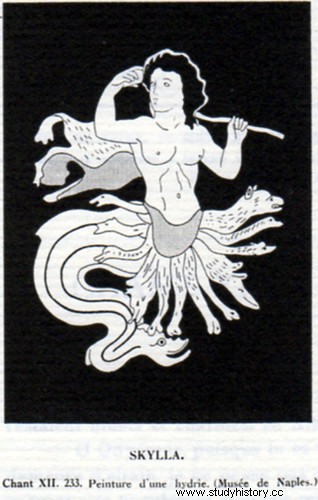
Ces horribles monstres sont situés dans le détroit de Messine, entre la Sicile et l’extrémité de la botte italienne. C’est un secteur où la navigation est difficile à cause des courants violents.
L’île de Thrinakié et les bœufs du Soleil.
“Tu arriveras ensuite à l’île Thrinakiè. Là, paissent les bœufs et les gras troupeaux de Hèlios.”
“Après avoir fui l’horrible Kharybdis et Skyllè, nous arrivâmes à l’île irréprochable du dieu. Et là étaient les bœufs irréprochables aux larges fronts et les gras troupeaux du Hypérionide Hèlios. Et comme j’étais encore en mer, sur la nef noire, j’entendis les mugissements des bœufs dans les étables et le bêlement des brebis; et la parole du divinateur aveugle, du Thébain Teirésias, me revint à l’esprit, et Kirkè aussi qui m’avait recommandé d’éviter l’île de Hèlios qui charme les hommes. Alors, triste dans mon cœur, je parlai ainsi à mes compagnons :
– Écoutez mes paroles, compagnons, bien qu’accablés de maux, afin que je vous dise les oracles de Teirésias et de Kirkè qui m’a recommandé de fuir promptement l’île de Hèlios qui donne la lumière aux hommes. Elle m’a dit qu’un grand malheur nous menaçait ici. Donc, poussez la nef noire au-delà de cette île.”
Trinacria est l’ancien nom grec de la Sicile, “la fourche à trois dents”, appelée ainsi à cause de sa forme triangulaire.
-
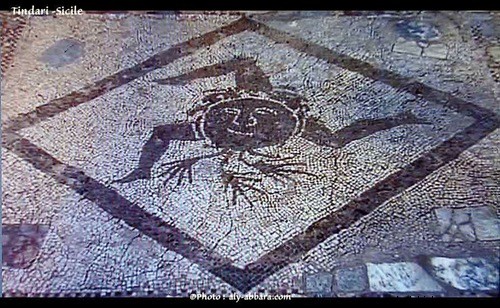
- Emblème de la Sicile
7 ans dans l’île de la nymphe Calypso
"Il y a au milieu de la mer une île, Ogygiè, qu’habite Kalypsô, déesse dangereuse, aux beaux cheveux, fille rusée d’Atlas; et aucun des Dieux ni des hommes mortels n’habite avec elle. Un daimôn m’y conduisit seul, malheureux que j’étais ! car Zeus, d’un coup de la blanche foudre, avait fendu en deux ma nef rapide au milieu de la noire mer où tous mes braves compagnons périrent. Et moi, serrant de mes bras la carène de ma nef au double rang d’avirons, je fus emporté pendant neuf jours, et, dans la dixième nuit noire, les dieux me poussèrent dans l’île Ogygiè, où habitait Kalypsô, la déesse dangereuse aux beaux cheveux. Et elle m’accueillit avec bienveillance, et elle me nourrit, et elle me disait qu’elle me rendrait immortel et qu’elle m’affranchirait pour toujours de la vieillesse; mais elle ne put persuader mon cœur dans ma poitrine.
Et je passai là sept années, et je mouillais de mes larmes les vêtements immortels que m’avait donnés Kalypsô. Mais quand vint la huitième année, alors elle me pressa elle-même de m’en retourner, soit par ordre de Zeus, soit que son cœur eût changé. Elle me renvoya sur un radeau lié de cordes, et elle me donna beaucoup de pain et de vin, et elle me couvrit de vêtements divins, et elle me suscita un vent propice et doux. Je naviguais pendant dix-sept jours, faisant ma route sur la mer, et, le dix-huitième jour, les montagnes ombragées de votre terre m’apparurent, et mon cher cœur fut joyeux."
Calypso est une nymphe du soleil couchant, ce qui fait que les chercheurs situent Ogygie à Ceuta, une presqu’île située en face de Gibraltar. Ulysse va passer 7 ans sur cette île en compagnie de la nymphe et ne sera délivré que par l’intersession des dieux qui obligeront la nymphe amoureuse à se séparer d’Ulysse.
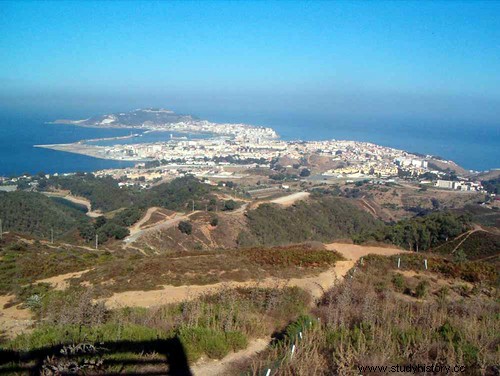
Ce site aux portes de la Méditerranée est probable, Calypso étant réputée vivre en solitaire et très éloignée des mortels et des dieux. La description par Homère de la construction du radeau voilé d’Ulysse est d’une précision remarquable (voir le Préambule).
Ulysse chez les Phéaciens
"Malheureux ! j’allais être accablé de nouvelles et nombreuses misères que devait m’envoyer Poseidaôn qui ébranle la terre.
Et il excita les vents, qui m’arrêtèrent en chemin; et il souleva la mer immense, et il voulut que les flots, tandis que je gémissais, accablassent le radeau, que la tempête dispersa; et je nageai, fendant les eaux, jusqu’à ce que le vent et le flot m’eurent porté à terre, où la mer me jeta d’abord contre de grands rochers, puis me porta en un lieu plus favorable; car je nageai de nouveau jusqu’au fleuve, à un endroit accessible, libre de rochers et à l’abri du vent. Et je raffermis mon esprit, et la nuit divine arriva. Puis, étant sorti du fleuve tombé de Zeus, je me couchai sous les arbustes, où j’amassai des feuilles, et un dieu m’envoya un profond sommeil. Là, bien qu’affligé dans mon cher cœur, je dormis toute la nuit jusqu’au matin et tout le jour. Et Hèlios tombait, et le doux sommeil me quitta. Et j’entendis les servantes de ta fille qui jouaient sur le rivage, et je la vis elle-même, au milieu de toutes, semblable aux immortelles. Je la suppliais, et elle montra une sagesse excellente bien supérieure à celle qu’on peut espérer d’une jeune fille, car la jeunesse, en effet, est toujours imprudente. Et elle me donna aussitôt de la nourriture et du vin rouge, et elle me fit baigner dans le fleuve, et elle me donna des vêtements. Je t’ai dit toute la vérité, malgré mon affliction.
Et Alkinoos, lui répondant, lui dit :
– Mon hôte, certes, ma fille n’a point agi convenablement, puisqu’elle ne t’a point conduit, avec ses servantes, dans ma demeure, car tu l’avais suppliée la première.
Et le subtil Odysseus lui répondit :
– Héros, ne blâme point, à cause de moi, la jeune vierge irréprochable. Elle m’a ordonné de la suivre avec ses femmes, mais je ne l’ai point voulu, craignant de t’irriter si tu avais vu cela; car nous, race des hommes, sommes soupçonneux sur la terre."
L’île de Phéaciens est située à divers endroits selon les chercheurs, allant de l’Italie aux îles grecques orientales. En fait, comme le dit Homère, elle se situe à une demi-journée de navigation à l’est de la plus grande île grecque, Eubée, donc ce pourrait être Skyros, île des Sporades située à 24 km d’Eubée :
“même par-delà l’Euboiè, que ceux de notre peuple qui l’ont vue disent la plus lointaine des terres, quand ils y conduisirent le blond Rhadamanthos, pour visiter Tityos, le fils de Gaia. Ils y allèrent et en revinrent en un seul jour. Tu sauras par toi-même combien mes nefs et mes jeunes hommes sont habiles à frapper la mer de leurs avirons.”
Le périple d’Ulysse se termine, il lui reste à reconquérir son épouse Pénélope qu’assiège une nuée de prétendants.

